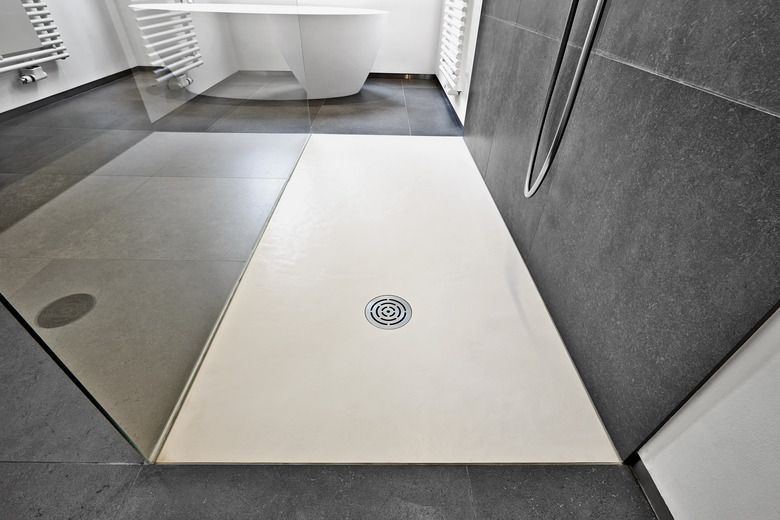How To Cap An Old Shower Drain
It's startling how taking out an old shower inside your bathroom will change the atmosphere in your bathroom. Redesigning it with a new shower enclosure allows you the opportunity to start over again. Or perhaps you prefer eliminating the shower entirely, giving your bathroom the feeling of luxurious spaciousness.
But taking out the shower itself isn't enough. Unless you plan to attach a new shower to the old shower drain pipe, you're going to have to cap it. Capping off a drain pipe prevents sewer gasses from rising into your home and allows you to finish the floor over it.
Get the Correct Size
Measure the diameter of the drain pipe — the distance across the center of the pipe — by hooking the tape measure over the pipe wall on one side and measuring across. Drain pipes are usually from 1 1/4 inches to 4 inches in diameter, with showers typically measuring 2 inches.
Also note the pipe material. Lead pipes are rare except in homes built in the first years of the 1900s and earlier. If your pipe is lead, consult a plumber. Otherwise, your shower drain pipe is likely plastic, copper or possibly cast iron.
Clean and Prepare the Pipe
Swirl a generous coating of pipe cleaner/primer around the outside of the pipe, encircling it three to four times, or as the product manufacturer instructs. Use the dauber inside the can, attached to the lid, to apply. Using a cleaner/primer removes oil, grime and other contaminants, allowing the cap to better seal to the pipe. In many locations, building code requires the use of a primer.
Spread a generous coating of pipe cement — if your drain pipe is either white PVC or gray ABS plastic products — similar to how you applied the cleaner/primer. Swirl around the exterior of the drain pipe three times, then coat the inside of the drain plug fitting with another three rounds of cement.
Install the Drain Cap
For PVC or ABS drains, fit the cap over the drain pipe and twist slightly to lock into place. A quarter turn is generally sufficient — avoid overtightening, which may damage the pipe or connection. Leave the installation undisturbed while the cement cures and dries, as instructed by the manufacturer, or a minimum of 24 hours to be on the safe side.
For a cast iron pipe, slide a cap designed for this material down over the top of the shower drain pipe. If provided with the cap, push a rubber sleeve on first then follow with the cap. Tighten the metal strapping that encircles the cap, using a ratchet torque wrench to ensure an air-tight seal. Alternatively, use a screwdriver or other tool as directed by the manufacturer.
Install a Copper Drain Cap
For a copper drain pipe, wrap a piece of 120-grit emery cloth around the exposed end of a copper drain pipe and work it back and forth — both clockwise and counterclockwise — for a minute or two to scuff the pipe's surface. Stop when the pipe begins to shine. Use a wire brush to treat the inside of the cap pipe fitting similarly.
Brush on a thin layer of flux — the soldering paste that seals the pipe fitting to the pipe — around the exterior of the pipe using an acid brush, which is a special paintbrush often used for adhesives, acids and other special solvents and solutions. Spread a thin layer around the inside of the cap fitting similarly. Immediately push the cap over the drain pipe and down until snug.
Solder the Copper Connection
Spread a piece of fireproof material such as a sheet of metal around the pipe to protect surrounding surfaces and prevent igniting a fire. Grab a fire extinguisher and keep it near if possible. Unroll a 6- to 8-inch long length of lead-free solder. Turn on a propane torch and adjust the flame to produce a strong, blue-centered cone of fire.
Touch the flame to the pipe-and-fitting connection. Heat the connection for a minute or two to liquify the flux inside the connection. Touch the tip of the length of solder to the pipe beneath the cap, where the ridge forming the cap-to-pipe connection ends. Feed the solder wire to the pipe as it melts, as if you were writing on a cake with frosting.
Encircle the entire cap-to-pipe connection with the solder, a process known as "sweating the joint," and remove both the torch and the remaining solder when finished. Examine the joint, looking for holes or gaps after the pipe has cooled a minute. Wipe away excess solder with a cloth and remove the heat shield before putting up your tools.
